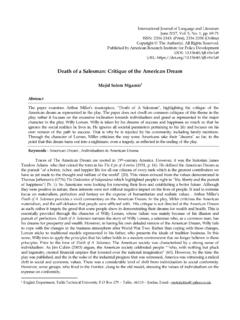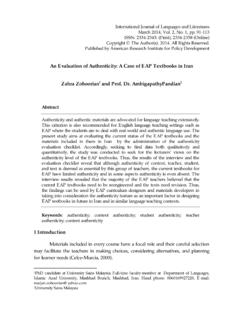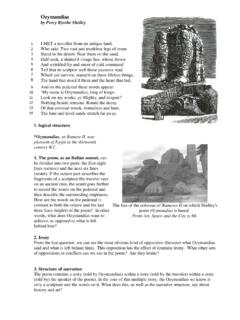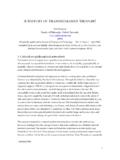Transcription of “Unveiling the Concept of Androgyny in Mary Shelley’s ...
1 International Journal of Languages and Literatures June 2014, Vol. 2, No. 2, pp. 307-322 ISSN: 2334-234X (Print), 2334-2358 (Online) Copyright The Author(s). 2014. All Rights Reserved. Published by American Research Institute for Policy Development unveiling the Concept of Androgyny in Mary Shelley s Frankenstein Marjana Mukherjee. & Dr. Joydeep Banerjee2 Abstract Mary Shelley s Frankenstein (1818) has been critically analyzed from both masculine and feminine this paper, my focus will be to highlight the fact that all the characters do try to conform to their socially assigned roles of being a male or a female but very often they are not able to hide their androgynous state of possessing both male and female characteristics. This paper tends to highlight the endeavor on the part of the female author to seek equality by consciously diminishing the Concept of male superiority over the female and portraying that both function simultaneously in an individual and thus there is a conscious blurring of the differences.
2 It focuses primarily on the imbalance that is caused if one tries to negate the role of Androgyny . Harmony can be attained only in unification. Keywords: Mary Shelley, Frankenstein, masculine, feminine, androgynous In 1890, Florence Fenwick Miller (1854-1935), a midwife turned journalist, described woman s position concisely: Under exclusively man-made laws women have been reduced to the most abject condition of legal slavery in which it is possible for human beings to be the arbitrary domination of another s will, and dependent for decent treatment exclusively on the goodness of heart of the individual master .(From a speech to the National Liberal Club). 1 Research Scholar at National Institute of Technology, Durgapur, India.
3 Email id: +91 9874325295 2 Assistant Professor in the Department of Humanities and Social Sciences at National Institute of Technology, Durgapur, India. Email id- +91 9434788054 308 International Journal of Languages and Literatures, Vol. 2(2), June 2014 Middle-class women who wanted to write were hampered by the conventional image of ladies as submissive, pious, gentle, loving, serene, domestic angels; they had to overcome the conventional patronizing, smug, contemptuous sentimentalizing of women by reviewers like George Henry Lewes, who looked down on women writers: Women's proper sphere of activity is elsewhere [than writing]. Are there no husbands, lovers, brothers, friends to coddle and console? Are there no stockings to darn, no purses to make, no braces to embroider? My idea of a perfect woman is one who can write but won' Your path is the path of perdition; your literary impulses are the impulses of Satan.
4 Burn your pens and purchase wool (68). Those women who overcame the restrictions imposed by their social roles and did write found it more difficult to challenge or reject society's assumptions and expectations than their male counterparts. Women authors wrote in the discourse of their male contemporaries because the patriarchal education system had trained them to read from the men s point of view as they are promoted as universal even though they are clearly male-centered. Women s texts were rejected by the male critics because of lack of originality or substance. Thus, if women authors wanted their works to be accepted then they had to write in accordance to the male generated Concept of writing. Another way adopted by women was to opt for a masculine pen name or stay anonymous and thus keep their identity hidden.
5 In a world wrought with a history of sexism and gender inequality, female writers have hidden their true gender behind the veil of masculine pen names for centuries so that their work was taken seriously in an era when authoresses were looked on with severe prejudice. A few instances are Mary Ann Evans writing under the pen name of George Eliot, Charlotte Bronte published her works under the masculine name Currer Bell, Emily Bronte opted for the male name of Ellis Bell and so on. As observed by Daniel Lewis, representations of masculinities found in texts written by women authors highlight the dire need to negotiate a place for female authors within a male-dominated industry specifically and within a male-dominated society in male-dominated society, female-authored representations of masculinity must deal with the dominant representations of male gender identity represented by men, and that they must do it, as Pratt describes, through a process wherein they select and invent from materials transmitted by a dominant or metropolitan culture.
6 This follows Judith Butler s theory of how texts work against hegemony by repeating and perverting the language found in the dominant discourse. Mukherjee & Banerjee 309 Occasionally, we also find that these texts written by female authors adopt thesematerials to reinforce patriarchy rather than attempting to destabilize and warp the gender hierarchy. These texts are not merely progressive or reactionary, they are representing masculinities that sometimes reflect aspects of the current patriarchal order while simultaneously attempting to disrupt other aspects of that system. Early in the article Pykett asks, [w]hat kinds of narratives about women, gender and sexuality did women write once they had the advantage of telling their own story in fiction, poetry, magazine articles, conduct books, pamphlets, biographies and autobiographies?
7 Were these stories in fact their own, or did the women writers of the nineteenth century still write to a male or masculinist script? (78). Pykett argues that women s writing was to a great extent shaped by male-controlled or masculinist institutions of publishing and by a gendered critical discourse which was fairly comprehensively internalized by female writers and reviewers. A look at female-authored representations of masculinity shows that these texts, at times, contest as well as support hegemonic definitions of masculine gender identity for the working, middle, and upper-classes. Thus, Pykett appeals to move beyond the restricting binaries help us to gauge the labyrinthine role played by women authors and the cumbersome and opposing ways in which literature has tried to change or consolidate the traditional notion of gender roles.
8 Women authors were not in a position to defy the conventional norms of patriarchy considering their position in the male-dominated society. Most lived in a state which was a little better than slavery. They had to obey men, because in most cases men held all the resources and women had no independent means of subsistence. Girls received less education than boys, were barred from universities, and could obtain only low-paid jobs. Women's sole purpose was to marry and reproduce. If a woman was unhappy with her situation there was, almost without exception, nothing she could do about it. Signs of rebellion were swiftly crushed by fathers, husbands, even brothers. Judge William Blackstone had announced that husbands could administer "moderate correction" to disobedient wives, and there were other means: as late as 1895, Edith Lanchester's father had her kidnapped and committed to a lunatic asylum for cohabiting with a man.
9 In her Autobiography, Margaret Oliphant makes clear her awareness that she participated in a tradition of female authorship rather than accepting the roles sketched out by society for women: 310 International Journal of Languages and Literatures, Vol. 2(2), June 2014 I had no table even to myself, much less a room to work in, but sat at the corner of my family table with my writing-book, with everything going on as if I had been making a shirt instead of writing a Miss Austen I believe wrote in the same The family were half ashamed to make it known that she was not just a young lady like others, doing her embroidery. (23-24) Thus, the social scenario made it difficult for women to assert their individuality. Rebelling against the norm was simply out of the question for a work to gain recognition.
10 So it was seen that most women authors tried to opt for a balance in their writing by either promoting masculinity or equating man and woman on the same platform. The latter was veiled and rarely done. A close analysis of Mary Shelley s novel Frankensteinhelps us reaffirm this view. Frankenstein or The Modern Prometheuswas first published in 1818by the small London publishing house of Lackington, Hughes, Harding, Mavor, & Jones. It was issued anonymously, with a preface written for Mary by Percy Bysshe Shelley and with a dedication to philosopher William Godwin, her father. It was published in an edition of just 500 copies in three volumes, the standard "triple-decker" format for 19th-century first second edition of Frankenstein was published on 11 August 1822 in two volumes (by G.)




